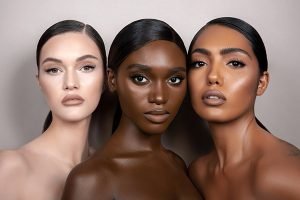
Having a good understanding of your skin tone and undertone is vital when choosing {make up}, especially when it comes to your {foundation} and {concealer}. Getting it right is the difference between looking orange or grey-tinged and looking natural and radiant (we know which camp we want to fall under!).
So how can you work out what your skin tone and undertone are? And what’s the difference between the two anyway – can’t the two terms be used interchangeably? (Spoiler: they can’t.)
We’re on hand to guide the way – let’s take a look at the difference between the two, the main skin tones and undertones and how to determine where you sit. And that’s not all, oh no. {Connor} from our {Cult Concierge} team is on hand with expert tips to help you choose the best make up for your undertone, so that you can get the luminous complexion you deserve.
WHAT’S THE DIFFERENCE BETWEEN SKIN TONE AND SKIN UNDERTONE?
Your skin tone is determined by the amount of melanin in your epidermis. It can change with sun exposure (so you might have a different skin tone each season) and with skin problems such as {acne} and {rosacea}.
Your skin undertone, on the other hand, is the subtle cool, warm or neutral colour beneath your skin’s surface that shines through onto your face. While your skin tone may change, your undertone will always be the same.
THE FOUR MAIN SKIN TONES
- Light
- Fair
- Medium
- Dark
THE THREE MAIN SKIN UNDERTONES
- Cool
- Warm
- Neutral
Of course, skin colour can’t be categorised into such a small handful of options, which is why an increasing number of foundation ranges are not only expanding their shade range to ensure they now cater to the spectrum of skin tones, but also come in an array of undertones so it’s now (theoretically) even easier to find your perfect match… providing you feel confident about whether you’re cool (‘C’, ‘P’ for pink or ‘R’ for red), warm (often ‘Y’ for yellow or ‘G’ for gold) or neutral (‘N’).
HOW TO DETERMINE YOUR SKIN TONE
You probably already have a good idea about your skin tone, as it’s fairly easy to tell whether yours is fair, light, medium or dark. But if you’re not quite sure, here are a couple of things to do or think about:
LOOK AT YOUR JAWLINE IN NATURAL LIGHT
Grab a mirror and take a good look at your skin in natural light. The jawline is a good area to focus on, as it’s usually less affected by colour changes than the rest of your face. From here, you should be able to determine if your skin tone is light, fair, medium or dark.
HOW DOES YOUR SKIN REACT TO THE SUN?
If you tan easily, you’ve likely got a medium or dark skin tone, while if you’re prone to burning then your skin tone is probably light or fair.
HOW TO DETERMINE YOUR SKIN UNDERTONE
Your undertone is what dictates the hues that suit you best. We’ve all had times when those around us notice that a colour really makes us look ‘alive’ – that’s a sign that you’ve alighted on a shade that really complements your colouring.
If you have warm undertones, it means that your skin is predominantly yellow, gold and olive, whereas those with cooler colouring have skin composed of pink, blue or red tones. You can of course be somewhere in-between – in which case, you’d be classed as neutral (and the colour world’s your oyster). Still at a loss? Here are some simple ways to work out where you sit…
THE VEIN TEST
In natural light, look at the veins on your wrist (try not to do this when you’re cold as veins will be constricted so they’re less visible). If your veins look blue, you’re cool and if they have a greener tint, this is due to your warm undertone affecting their appearance (remember school? Blue + yellow = green). If they’re neither one thing nor the other, you might be neutral-toned.
THE JEWELLERY TEST
Precious metals are another way of working out your undertone. If silver makes your skin look luminous, you’re typically cool – while if gold is more flattering, you have warm or golden tones. Both look just as good? You have neutral undertones.
THE WHITE T-SHIRT TEST
Hold a white t-shirt up to your skin. If your skin looks a bit rosy next to it, you’re likely to be cool toned. If your face looks more yellow, you’re likely to be warm toned. If you don’t see a change, you’re probably neutral.
THE BEST MAKE UP FOR YOUR UNDERTONE
Here are Cult Concierge expert Connor’s top tips for choosing the best make up for your undertone.
MAKE UP FOR COOL UNDERTONES
FOUNDATION FOR COOL UNDERTONES
Choose a shade with a cool or pink undertone (look for symbols C, P or R). {Urban Decay’s} {Stay Naked Foundation} comes in various shades that are perfectly suited to cool undertones.
